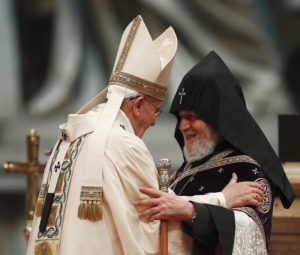Pope Francis is visiting Armenia this weekend, the world’s oldest Christian nation and one of the most devoutly Christian societies on earth. Thanks to the efforts of St. John Paul II, the main theological barrier between the Catholic Church and the Church to which most Armenians belong was eliminated. With determined papal leadership, the others could be lifted, too.
In 301 AD, twelve years before Constantine legalized Christianity in the Roman Empire, King Tiridates III made Christianity the official religion of Armenia, the first national ruler to do so. The Armenians were subsequently conquered by the Romans, Arabs, Persians, Ottomans, and Soviets. In 1915, the Young Turks government attempted to exterminate them, massacring 1.5 million. In 1988, an earthquake killed up to 50,000 Armenians. That same year, a war between Armenia and Azerbaijan claimed tens of thousands of lives.
Yet despite this tragic history, Armenian culture survived, largely thanks to the Armenians’ steadfast fidelity to their Christian faith. According to a 2012 survey, 92 percent of Armenians consider themselves religious, the third-highest percentage anywhere (in the United States it’s 60 percent).
Most members of this ancient Christian nation, however, are not in full communion with Rome. In the fifth century, the Christian Church was bitterly divided over questions about the nature of Christ. The Nestorians believed He had two completely separate natures, one human and one Divine. The Monophysites, however, believed that the Son of God had one nature that was simultaneously human and divine. In 451, the Council of Chalcedon decreed that Christ had two natures; He was fully human and fully divine, in one person.
Representatives of the Armenian Church were unable to attend the council in Chalcedon, because Armenia was busy fighting the Persians. Like the Egyptian Copts and the Syrian Jacobites, the Armenian Church rejected the Chalcedonian dogma and officially broke with Rome. In 662, the Armenian bishops accepted the Chalcedonian teaching on Christ’s nature, but the catholicos (the head of the Armenian Apostolic Church who resides in Etchmiadzin) turned back to Monophysitism. Some members of the Armenian diaspora became Catholics, and in 1742 an Armenian Uniate Catholic Church (which currently has about 750,000 members) was founded, although 9 million Armenians belong to the Apostolic Church.

In recent decades, however, Rome and Etchmiadzin have become closer to reunification than ever. This was in large degree thanks to the genius of Pope St. John Paul II, a true ecumenist. He built up rapport with Karekin I, the Armenian catholicos (1995-1999), who himself successfully ended a decades-long schism in the Armenian Apostolic Church between the diaspora and the faithful in formerly Soviet Armenia.
In 1996, the leaders of the two churches signed a document in which they agreed on the Chalcedonian teachings on Christ’s nature. They concluded that there were misunderstandings related to poor translations of the Chalcedonian texts and the Armenians’ absence from the council. Five years later, John Paul II travelled to Armenia and signed another document with the catholicos Karekin II condemning the 1915 genocide of the Armenian people at the hands of Turkey.
Thanks to the pioneering vision of St. John Paul II and Karekin I, the main obstacle to communion between the Catholic and Armenian Apostolic Churches has been lifted. Furthermore, unlike the Orthodox Churches, the Armenians do not have a centuries-old grudge against Rome.
Nonetheless, work still needs to be done for unity to be possible. Because the Armenians severed ties with the universal Church more than fourteen centuries ago, the Armenian Apostolic Church wasn’t present at councils that accepted other dogmas, from papal infallibility to the Immaculate Conception.
Yet if one pope’s courage was enough to remove the biggest theological barrier between Rome and the Armenia, overcoming the others is conceivable. In fact, with the right papal leadership, full communion in our time.
The pope, as Pontifex Maximus, is the builder of bridges. John Paul took the big step. If dialogue with other Christian churches is reduced to politically correct photo opportunities and empty talk, then it is pointless. In essence, that would make it a celebration of division.
As with many other aspects of his pontificate, Francis’ relations with other Christian Churches have been inconsistent and unpredictable. Earlier this year, he met with Patriarch Kirill, head of the Russian Orthodox Church, and the two signed a declaration expressing the desire to reestablish full communion. This is truly historic.
Francis has made the bizarre decision, however, to travel to Sweden in October to celebrate the 500th anniversary of the Protestant Reformation. The prefect of the Congregation for the Doctrine of the Faith, Cardinal Gerhard Ludwig Müller, was absolutely correct when he said that the Reformation, the cause of painful divisions between Christians that led to wars and persecutions in 16th and 17th century Europe, is “nothing to celebrate.”
Let us pray that the primary legacy of Francis’ trip to Armenia will be to make full unity with the Armenian Apostolic Church even more plausible. Compared to the Orthodox Churches, full communion with the Armenians is much easier and would not be theological fiction. St. John Paul II and Karekin I’s 1996 declaration, after all, shows that determined and courageous leadership can overcome centuries-old theological divisions.















